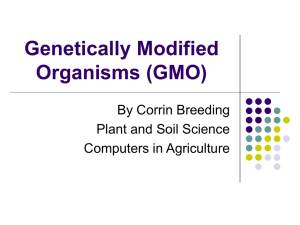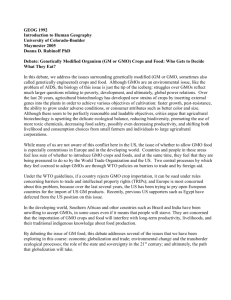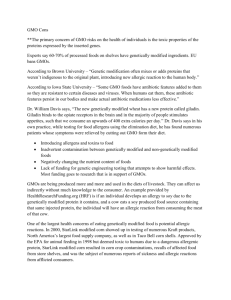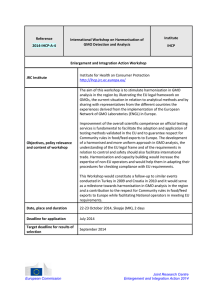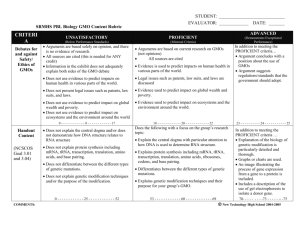Genetica - WordPress.com
advertisement
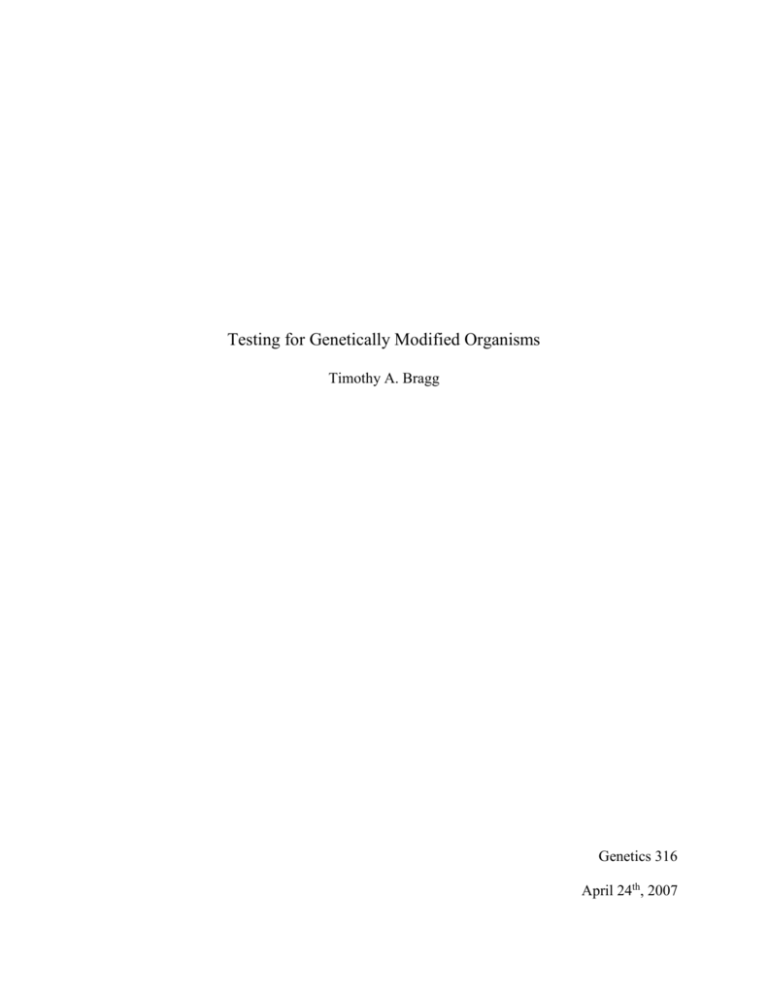
Testing for Genetically Modified Organisms Timothy A. Bragg Genetics 316 April 24th, 2007 Introduction – Through recent discoveries in genetic modification, it has been found to be beneficial to modify plants in order to increase yields, improve taste, decrease pest invasiveness, and lower costs of producing the plants we rely on in our everyday lives. Some collective unions of people such as the European Union, have implemented strict policies to regulate how much GMOs as foods or ingredients of foods will be grown or imported. It is important in a situation such as this to use an easily repeatable and accurate process to detect GMOs in order to regulate how much of these foods and food ingredients are imported and utilized by these groups. PCR-based methods are highly utilized to test for these situations and enable marketers of these goods to apply proper labeling to GMO products. While some labels are less specific as to which GMOs are utilized, others are more specific, down to the strain of a particular GMO used. Various methods of faster and easier PCR analysis are being developed in order to expedite this process (Forte). Some specific examples of new and improved methods of PCR analysis are called Nucleospin, Qiagen, CTAB, Kingfisher, or Wizard extracts. Each has their own advantage in a given situation, but the Wizard procedure has been found to be one, which has the highest quantity of DNA, extracted. All the extraction techniques used in this research were found to be sufficient and could be competitive if price was a high concern of a lab facility. However, it was noted that the Wizard extraction method ranged from two to ten times more efficient at extracting DNA from the samples and might be a consideration if the quality of the sample was of bad quality or in very small quantity. Quantity was not the only concern of this research as it also mentioned that the Wizard method was successful due to its ability to recover a more structurally stable DNA template (Smith). It is also important to examine the possibility of false positives when examining the DNA via new or even long-time used methods. With the government involvement in regulation of these goods, the need to have an accurate method which doesn’t falsely label a product and tarnish a producer’s reputation, such as a false positive in a product which insists their product does not contain GMOs. It seems that in today’s market, about 50% or more as of 1999, of agricultural goods have been genetically modified. It has been argued that the prior process of crop breeding to produce new strains has comparable health risks, and in countries which test for GMO products, labeling has been added to allow consumers the choice of buying GMO foods or choosing to ensure that their food does not contain any GMO. Implementations, which quantify amounts of GMO, has lead to the exclusion of labels on products below a set amount of GMO/unit or per ingredient in products containing more than one known GMO (Ahmed). Public acceptance of GMOs has been an issue brought up in public discussion since its origin and has been thought of as both a positive good and a negative intervention against nature. Safeties for human consumption and for the surrounding environment affected by the genetically modified species are part of the controversial front, which has been considered. While inability to fully accept GMOs has somewhat inhibited the production of a more widespread use of these products, it has been generally left up to the consumer to decide in the marketplace. In some cases, the issue is as simple as not notifying the public of GMOs in products prior to consumption, during the early developmental phases. This may have lead to a certain amount of distrust in producers, as consumers were not first given the choice to consume these goods. While not meant to be a hidden secret of producers, it seems more as if the government regulations did not require the producers to inform the public of the change (Frewer). By creating plants that are resistant to herbicides, it is possible to less selectively use herbicides for weed control and therefore more cost effective to use an herbicide that will not harm the crop that has been genetically modified to resist such chemicals. This would allow a producer to use a cheaper herbicide while still successfully controlling a problem that reduces yield. There is a lot of controversy surrounding the use of GMOs such as the modification of soybeans to create a strand that is glyphosate-resistant (GR). This strain of soybeans has allowed for decreased costs in fuel for tractors which would otherwise be needed in weed removal and furthermore reduces pollution and soil compaction. Even with this obvious advantage, some producers choose to not use this strain in effort to gain profit by producing ‘tech free’ goods. In other words, if such a strain is to be a success, the genetically modified product must be cheap enough to produce to overshadow the loss of profit due to no longer being ‘tech free’. Once again, a new problem arises as the production of those without ‘tech free’ product increases; the supply has the possibility of exceeding the existing demand, which can inadvertently decrease the profit of the agricultural goods (Nelson). With such widespread use of GMOs I believe that Sunchips® brand corn chips do contain some form of genetic modification in at least one ingredient used. The public acceptance of GMOs is surprising, considering the data available to those interested in researching. I for one, am not against the modification of agricultural goods if at some point along the production of such goods, there has been some known gain in the efficiency of production without sacrificing safety of those consuming any of the GMO products. Methods – We prepared for the testing of GMOs by first creating a slurry via grinding up the Sunchips® brand corn chips and adding water at a proportion of 5 mL/g of food. The grinding was then done with a mortar and pestle and was thoroughly mashed before withdrawing 50μL and adding this to the 500 μL of InstaGene matrix. It should be noted that the mortar and pestle were washed very well with bleach between uses to prevent any false positives. This same process was used when creating a slurry of the non-GMO food control. Each tube was then shaken well to mix the slurry and the InstaGene matrix together. Both tubes were placed at 95°C in a water bath to incubate for 5 minutes. The samples were then centrifuged for 5 minutes before cooling them in the refrigerator until the PCR processing. Tube # DNA Master Mix 1 20 μL non-GMO food control DNA 20 μL Plant Master Mix (green) 2 20 μL non-GMO food control DNA 20 μL GMO Master Mix (red) 3 20 μL tested food DNA 20 μL Plant Master Mix (green) 4 20 μL tested food DNA 20 μL GMO Master Mix (red) 5 20 μL GMO positive control DNA 20 μL Plant Master Mix (green) 6 20 μL GMO positive control DNA 20 μL GMO Master Mix (red) Six PCR tubes were labeled 1-6 and filled with the contents shown in the table above. Special care was taken to avoid cross-contamination and to avoid disturbing the InstaGene beads. The samples were then placed into the thermal cycler to undergo the PCR. Electrophoresis of the PCR products was then carried out a week after the initiation of this investigation. The 3% agarose gel was created according to protocol and poured into the tray. The samples were prepared by first mixing 10 μL of Orange G loading dye with each PCR sample. Then 15 μL of molecular mass ruler was also added to each sample. After the samples had been mixed well, each was assigned a well in the electrophoresis gel and added carefully with a micropipette. Each sample was added to its assigned well in 15 μL increments rather than the usual 20 μL volume due to the small wells. After the electrophoresis, the gel was stained for 5 minutes, followed by a quick rinse and 3 rinses at 5 minutes each with warm water (40-55°C). Carry out the de-staining process until a proper contrast is seen with the assistance of a light source. Results – The results for the examination of the GMO analysis returned with unfortunate results. Neither the plant, nor the GMO tests showed any results for the Sunchips®. The control samples worked as they were intended and were shown to be positive for their assigned purpose. The control for plant primers (1) had a band at ~455 bp and the control for GMO primers (4) had a band at ~203 bp. The control for non-GMO (2) had no bands visible. A control used for nonGMO plant (3) had a band at ~455 bp. Unfortunately, the tests for GMO and plant DNA did not show any bands on the gel we created in lab. The ruler used to measure the bands worked as it was intended to indicate (7). Gel Plate 1 Non-GMO control (plant) 2 Non-GMO control (GMO) 3 GMO positive control (plant) 4 GMO positive control (GMO) 5 Sunchips® Plant 6 Sunchips® GMO 7 Molecular Weight Ruler (*) indicates presence of indicated primer Discussion – The results shown by the electrophoresis gel correctly indicated the values for all controls appropriately along with the correct number of bands for the molecular weight ruler. As indicated by the GMO test flowchart, the Sunchips® tested negative for GMOs, but the results also showed a negative test for plant DNA which should have undoubtedly shown as a positive. Because no bands were present for either test of the Sunchips® it is believable that a previous step had an error in protocol. A possible location in error may have come from an incomplete DNA amplification during PCR or even earlier in the process, as early as the first extraction from the slurry. If too much bleach was used to clean the mortar and pestle, it could have denatured the DNA before the extraction. However, it is reassuring to observe that the controls were working as intended and the error in procedure was not likely to have occurred after the PCR. References Ahmed, F. E. (2002, May 1). Detection of genetically modified organisms in foods. Trends in Biotechnology, 20(5), 215-223. Retrieved April 23, 2007, from Science Direct database. Forte V.T., Di Pinto A., Martino C., Tantillo G.M., Grasso G., Schena F.P. A general multiplexPCR assay for the general detection of genetically modified soya and maize. (2005) Food Control, 16 (6 SPEC. ISS.), pp. 535-539. Frewer, L., Lassen, J., Kettlitz, B., Scholderer, J., Beekman, V., & Berdal, K. G. (2004, July). Societal aspects of genetically modified foods. Food and Chemical Toxicology, 42(7), 1181-1193. Retrieved April 22, 2007, from Science Direct database. Nelson G.C., Bullock D.S. Simulating a relative environmental effect of glyphosate-resistant soybeans (2003) Ecological Economics, 45 (2), pp. 189-202. Smith, D. S., & Maxwell, P. W. (2007, March). Use of quantitative PCR to evaluate several methods for extracting DNA from corn flour and cornstarch. Food Control, 18(3), 236-242. Retrieved April 23, 2007, from Science Direct database
